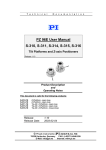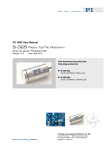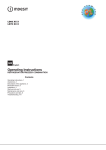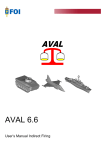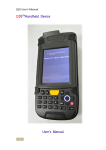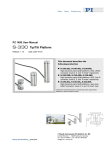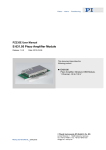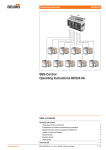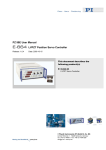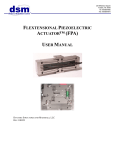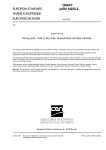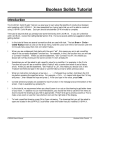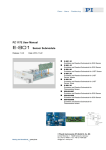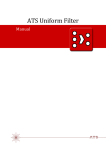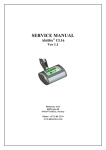Download PZ 96E User Manual Tilt Platforms and Z
Transcript
PZ 96E User Manual S-310, S-311, S-314, S-315, S-316 Tilt Platforms and Z-axis Positioners Release: 1.10 Date: 2003-02-04 This document describes the following Product(s): S-310.10 Z-Platform, open-loop S-314.10 Z-Platform, open-loop S-311.10 Tip-tilt / Z-Platform, open-loop S-315.10 Tip-tilt / Z-Platform, open-loop S-316.10 Tip-tilt / Z-Platform, closed-loop © Physik Instrumente (PI) GmbH & Co. KG Auf der Römerstr. 1 ⋅ 76228 Karlsruhe, Germany Tel. +49-721-4846-0 ⋅ Fax: +49-721-4846-299 [email protected] ⋅ www.pi.ws S-310 – S-316 Tip/Tilt Platforms Operating Manual PZ 96E Table of Contents 0. Manufacturer Declarations .............................................. 2 1. Introduction....................................................................... 3 1.1. Features....................................................................................... 3 1.2. Description ................................................................................... 3 2. Model Survey .................................................................... 4 3. Quick Start ........................................................................ 4 3.1. Mounting ...................................................................................... 4 3.2. Connecting to Controller .............................................................. 4 3.3. Testing ......................................................................................... 5 4. Operating Considerations................................................ 6 4.1. Travel Range ............................................................................... 6 4.2. Power Requirements ................................................................... 6 4.3. Dynamic Behavior........................................................................ 6 5. Working Principle ............................................................. 7 6. Technical Data .................................................................. 9 7. Dimensions ..................................................................... 12 © Copyright 1998–2003 by Physik Instrumente (PI) GmbH & Co. KG Release: 1.10 File:S-310_User_PZ96E110.doc, 353280 Bytes Release 1.10 [email protected] Page 1 S-310 – S-316 Tip/Tilt Platforms 0. Operating Manual PZ 96E Manufacturer Declarations Certification Physik Instrumente (PI) GmbH & Co. KG certifies that this product met its published specifications at the time of shipment. Warranty This PI product is warranted against defects in materials and workmanship for a period of one year from date of shipment. Duration and conditions of warranty for this product may be superseded when the product is integrated into (becomes a part of) other PI products. During the warranty period, PI will, at its option, either repair or replace products which prove to be defective. Limitation of Warranty The foregoing warranty shall not apply to defects resulting from improper or inadequate maintenance by the Buyer, Buyer supplied products or interfacing, unauthorised modification or misuse, operation outside of the environmental specifications for the product, or improper site preparation or maintenance. The design and connection of any circuitry to this product is the sole responsibility of the Buyer. PI does not warrant the Buyer's circuitry or malfunctions of PI products that result from the Buyer's circuitry. In addition, PI does not warrant any damage that occurs as a result of the Buyer's circuit or any defects that result from Buyer-supplied products. No other warranty is expressed or implied. PI specifically disclaims the implied warranties of merchantability and fitness for a particular purpose. Warnings ¾ Shock Hazard: Voltages up to 130 V can be present on PZT connectors. ¾ PZT Damage: Most piezo actuators can be destroyed by uncontrolled oscillation near the mechanical resonant frequency. If you observe resonance while configuring your system, switch off power to the actuators concerned immediately. Remember that any mass mounted on the platform will reduce the resonant frequency dramatically. Release 1.10 [email protected] Page 2 S-310 – S-316 Tip/Tilt Platforms 1. Operating Manual PZ 96E Introduction The S-310 to S-316 Z-positioners and multi-axis tip/tilt platforms are fast and compact units based on the triple-piezo-drive-supported platform design. All offer piston movement up to 12 µm and all but the S-310 and S-314 offer tip/tilt motion up to ± 600 µrad with sub-msec response and settling. 1.1. Features ¾ 10 mm Clear Aperture ¾ Triple-PZT-Actuator-Supported Platform ¾ Tilt Range up to ± 600 µrad ¾ Piston Movement up to 12 µm ¾ Open- and Closed-Loop Versions ¾ For Optics, Mirrors or Other Components Fig. 1: S-314.10 Z-Platform (open-loop) 1.2. Description S-310 to S-316 tilt platforms are equipped with three low-voltage (0 to 100 V) piezoelectric linear drives spaced at 120° intervals. Control of the tip/tilt versions is complicated because expansion of an individual PZT actuator can affect both θX and θY rotation. External coordinate transformation (software or hardware) is required to allow platform position commands in θX and θY coordinates, and that hardware or software will determine how the tip/tilt angles are defined. See the equations and Fig. 2 on page 7 for examples. The triple-piezo-actuator design exhibits excellent angular stability over a wide temperature range. Temperature changes only affect the vertical position of the platform (piston motion) and have no influence on the angular position. The units can be mounted in any orientation. In open-loop operation, the position of each actuator roughly corresponds to the drive voltage (see the discussion on p. 7 for calculating vertical position / platform angle as a function of actuator extension and see the "Tutorial: Piezoelectrics in Positioning" in the PI catalog or at www.pi.ws for more on the behavior of openloop PZTs). The open-loop models (S-310 to S-315) are ideal for applications where the position is controlled by an external loop based on data provided by a sensor (e.g. quad cell, CCD chip). The closed-loop version (S-316.10) offers absolute position control, high linearity and repeatability based on the internal high-resolution feedback sensor. Release 1.10 [email protected] Page 3 S-310 – S-316 Tip/Tilt Platforms 2. Operating Manual PZ 96E Model Survey Several different versions are available: S-310.10 Open-loop Z-actuator; all three piezo linear actuators are electrically connected in parallel, providing vertical positioning (piston movement) of the top ring. Only one drive channel is required. S-314.10 Open-loop Z-actuator; same as S-310.10 but with twice the travel range. S-311.10 Open-loop Z, tip/tilt positioner; all three piezo linear actuators can be driven individually or in parallel by a three-channel amplifier. Vertical (piston movement) positioning and tip/tilt positioning are possible. S-315.10 Open-loop Z, tip/tilt positioner; same as S-311.10 but with twice the tip/tilt and piston travel range. S-316.10 Closed-loop Z, tip/tilt positioner; all three piezo linear actuators are equipped with strain gauge position feedback sensors and can be driven individually (or in parallel) by a three-channel amplifier/ position servo-controller. Vertical positioning (piston movement) and tip/tilt positioning are possible. The integrated position feedback sensors provide sub-µrad resolution and repeatability (with PI control electronics). 3. Quick Start 3.1. Mounting You can mount the object to be positioned (for example, a mirror) on the platform using glue or three screws with M2.5 threads. Warnings ¾ Mounting screws longer than 3 mm may damage the internal flexure system. ¾ Do not overtighten mounting screws. ¾ Some models have visible assembly screws covered with sealing laquer. These screws must not be disturbed. Damage to the seal will void the warranty. The platform can be mounted in any orientation. By default, the platform metal case is floating. You should ground the mechanics if so required. 3.2. Connecting to Controller S-310 to S-316 platforms are used with position control electronics consisting of amplifier and—in case of closed loop operation—a PZT servo controller (see theTechnical Data table on page 9 for required devices). Make sure there is no voltage on the PZT output of the amplifier when you connect the platform to the controller. The best way to do so is to switch the controller off. The connections that need to made between platform and controller/amplifier are listed in the table below. For further information on connecting the platform to the controller, on controller setup and operation, refer to the User Manual of the appropriate controller, and to any associated software manuals. Release 1.10 [email protected] Page 4 S-310 – S-316 Tip/Tilt Platforms Operating Manual PZ 96E The Z-axis-only S-310 and S-314 platforms have only one connector for connecting to the PZT output socket of the amplifier. Their three PZTs are electrically connected in parallel. S-311, S-315 and S-316 platforms have three connectors for connecting to the PZT output socket of the amplifier, each connector cable is labeled with the PZT channel number. With these platforms all three PZTs can be driven individually. The three sensor connector cables of S-316 are each labeled with the sensor channel number. The correct PZT- and sensor-channel assignment must be observed when connecting the unit to the controller. The following table summarizes the connections that need to made with the controller*. Model Actuator/Positioner connector(s) Controller connector(s) for connecting with the actuator/positioner** S-310.10, S-314.10 open-loop Z-actuator PZT drive voltage: PZT drive voltage: 1 LEMO connector (male) 1 output socket on the amplifier module labeled ”PZT” S-311.10, S-315.10 open-loop Z, tip/tilt positioner PZT drive voltage: PZT drive voltage: S-316.10 closed-loop, Z, tip/tilt positioner PZT drive voltage: 3 LEMO connectors (male); 3 output sockets on the cables labeled “CH1,” amplifier module(s) labeled “CH2,” “CH3” “PZT”.* PZT drive voltage: 3 LEMO connectors (male); 3 output sockets on the cables labeled “CH1,” amplifier module(s) labeled “CH2,” “CH3” “PZT”* Sensors: Sensors: 3 LEMO connectors (female) cables labeled “CH1”, “CH2,” “CH3” 3 input sockets on the PZTservo-controller module(s) labeled “SENSOR”* * If calibrated at PI, the channel numbers will be indicated. ** Amplifier/controller modules for OEM applications may be provided with other connection facilities. For detailed information about connecting to position control electronics for OEM applications refer to the respective manuals. 3.3. Testing Before powering up the controller, check the system connections carefully. Warnings ¾ Shock Hazard: Voltages up to 130 V can be present on PZT connectors. ¾ PZT Damage: Most piezo actuators can be destroyed by uncontrolled oscillation near the mechanical resonant frequency. If you observe resonance while configuring your system, switch off power to the actuators concerned immediately. Remember that any mass mounted on the platform will reduce the resonant frequency dramatically. Power up the controller and perform a few test moves to make sure the system is working properly. Consult the controller/amplifier manual to determine the best way to do this. Release 1.10 [email protected] Page 5 S-310 – S-316 Tip/Tilt Platforms 4. Operating Considerations 4.1. Travel Range Operating Manual PZ 96E For maximum tilt range of the tip/tilt versions, the zero tip/tilt position must that with all three piezo actuators biased at 50 V. Be aware that all three PZT actuators move down to the bottom limit of the travel range when you switch the amplifier off. Linear travel and tilt angle are interdependent (see the discussion of tilt angles on page 7 for more information). The travel-range and tilt-angle values quoted in the documentation (see Technical Data table on page 9) refer to pure linear or pure angular motion. 4.2. Power Requirements In dynamic applications it is important to avoid exceeding the power-output capability of the amplifier. You can check this using the dynamic operating current coefficient of the PZTs (DOCC) which is given in µA per Hz and µm in the Technical Data table on p. 9: Multiply the PZT´s DOCC by the desired frequency and displacement. For calculations involving tilt motion, first calculate the corresponding motion of each actuator using the equations that describe your geometry, then use the DOCC to get the power requirements. Example S-314.10: Sinusoidal scan of 10 µm at 10 Hz requires approximately 1.5 mA drive current (DOCC = 15 µA per Hz and µm). The result has to be less than or equal to the average output current of the selected amplifier. For further information please refer to the "Tutorial" section of the PI Catalog, in particular page 4-32, or consult the same material at www.pi.ws → Products → Tutorial, (http://www.physikinstrumente.de/products/prdetail.php?secid=4-32). 4.3. Dynamic Behavior In addition to the amplifier, controller and sensor bandwidths, the maximum operating frequency of a tilt platform depends on its mechanical resonant frequency. To estimate the effective resonant frequency of a tip/tilt system (platform + payload), the moment of inertia of the payload must also be considered. Moment of inertia of a rotationally symmetric payload (e.g. round mirror): 2 3R 2 + H 2 H + +T I m = m 12 2 Moment of inertia of a rectangular payload (e.g. rectangular mirror): 2 L2 + H 2 H + +T I m = m 2 12 where: m = Payload Mass [g] IM = Moment of inertia of the payload [g·mm2] L =Payload length perpendicular to the tilt axis [mm] Release 1.10 [email protected] Page 6 S-310 – S-316 Tip/Tilt Platforms H Operating Manual PZ 96E = Payload thickness [mm] T = Distance, pivot point to platform surface (see technical data table on p. 9 for individual model) [mm] R = Payload radius [mm] Using the resonant frequency of the unloaded platform (see Technical Data table, p. 9) and the moment of inertia of the payload, the system resonant frequency is calculated according to the following equation: Resonant frequency of a tip/tilt platform system (including payload): f '= f0 1+ IM I0 where: f' = Resonant frequency of platform with payload [Hz] f0 = Resonant frequency of unloaded platform [Hz] I0 = Moment of inertia of the unloaded platform (see technical data table) [g·mm2] IM= Moment of inertia of the payload [g·mm2] For more information on static and dynamic behavior of piezo actuators, see the "Tutorial" section of the PI Catalog, in particular pages 4-27 ff, or consult the same material at www.pi.ws → Products → Tutorial, (http://www.physikinstrumente.de/products/section4/content.php). 5. Working Principle The three PZT actuators which support the platform are arranged symmetrically around the centerpoint (see Fig. 2 at right). As you can see in Fig. 3 on p. 12, they come labeled as channels 1, 2 and 3, clockwise from the cable exit point. There are many ways to define the axes and tip/tilt angles. The definitions you use will depend on the geometry of your application. The geometry and formulas shown in Fig. 2 are based on a system with the Y-axis passing through one of the actuators (designated A) and the tilt angles measured around fixed axes (i.e. the angles are measured in a= b 3, 2 ∅= 2b 3 3 Fig. 2 Triple-piezo-drive tip/tilt platform geometry, viewed from above. A, B, C are the three PZT drives. vertical planes, not planes necessarily perpendicular to the platform). For this example, the formulas below would be used to calculate α and β. These formulas show the relationship between the displacement of each actuator (from the bottom limit of the travel range = extension at 0 V) and the tip/tilt angles (in radians). It Release 1.10 [email protected] Page 7 S-310 – S-316 Tip/Tilt Platforms Operating Manual PZ 96E uses the sin α = α approximation, making it valid for small angles, covering the full travel range of the device. α = [A – ½(B+C)] / a β = (B-C) / b with A = constant Z = (A+B+C) / 3 where A, B, and C are the linear displacements of the corresponding piezo actuators (between 0 and 12 µm), α and β are the tilt motions in radians measured around fixed axes, Z is the linear displacement of the platform centerpoint. Equation 1: Triple-piezo-drive relation Example S-315 and S-316 Tilt Platforms Ø = 13.9 mm a = 10.4 mm b = 12.0 mm A, B, C actuator range: 0 to 12 µm αmin = [Amin – ½(Bmax+Cmax)] / a = -12 µm / 10.4 mm = -1.15 mrad αmax = [Amax – ½(Bmin+Cmin)] / a = 12 µm / 10.4 mm = 1.15 mrad βmin = (Bmin-Cmax) / b = -12 µm / 12.0 mm = -1 mrad βmax = (Bmax-Cmin) / b = 12 µm / 12.0 mm = 1 mrad Z = 0 to 12 µm Release 1.10 [email protected] Page 8 6. Technical Data Models Active axes * Open-loop tilt angle @ 0 to 100 V * Closed-loop tilt angle ≥ Open-loop linear travel @ 0 to 100 V Closed-loop linear travel ≥ Integrated feedback sensor S-310.10 Z 6 - S-314.10 Z 12 - S-311.10 Z,θX, θY ±300 6 - S-315.10 Z,θX, θY ±600 12 - Closed-loop *** angular resolution ≤ Closed-loop / open-loop *** linear resolution ≤ Stiffness (Z) Electrical capacitance ** Dynamic operating current coefficient (DOCC) Diameter (max.) of mounted mirrors/optics Unloaded resonant frequency (f0) Resonant frequency w/ ∅ 15 x 4 mm glass mirror Resonant frequency w/ ∅ 20 x 4 mm glass mirror Distance, pivot point to platform surface (T) Platform moment of inertia Operating temperature range Voltage connection - / 0.1 20 0.7 15 25 9.5 6.5 6.1 - 20 to 80 1 x VL, 2 m cable - - / 0.2 10 1.4 15 25 5.5 4.4 4.2 - 20 to 80 1 x VL, 2 m cable - - / 0.1 20 3 x 0.23 3x5 25 9.5 5.5 4.4 5 150 - 20 to 80 3 x VL, 2 m cable - - / 0.2 10 3 x 0.45 3x5 25 5.5 4.1 3.4 5 150 - 20 to 80 3 x VL, 2 m cable - 45 N-S / N-S 19.5 55 N-S / N-S 28.5 45 N-S / N-S 19.5 55 N-S / N-S 28.5 Sensor connection Weight (w/o cables) Material (case / platform) Length (L) Recommended amplifier/controller S-316.10 Z,θX, θY ±600 ±600 12 12 3 x strain gauge ±0.05 0.2 / 0.4 10 3 x 0.45 3x5 25 5.5 4.1 3.4 5 150 - 20 to 80 3 x VL, 2 m cable 3 x L, 2 m cable 55 N-S / N-S 28.5 Low- and Medium-Power Applications: E-500 (E-501) chassis +E-503 (three-channel amp.) +optional E-515/E-516 display/interface. Alternatively, E-663 (3-channel amplifier) or E-610.00 OEM amplifier module Units Notes µrad ±20% µrad µm ±20% µm A2 A3 A5 A6 B µrad nm N/µm ±20% µF ±20% µA/(Hz x µm) mm kHz ±20% kHz ±20% kHz ±20% mm gmm² °C C1 C1 D1 F1 F2 G2 G3 G3 H2 J1 J2 g ±5% L mm Notes *For maximum tilt range, all three piezo actuators must be biased at 50 V. Linear travel and tilt angle are interdependent. The values quoted here refer to pure linear / pure angular motion about fixed axes, actuators starting from the center positions. See discussion on page 8 for more information. **Dynamic Operating Current Coefficient in µA per Hertz and mm (per actuator). Example S-314.10: Sinusoidal scan of 10 mm at 10 Hz requires approximately 1.5 mA drive current. For tilt calculation see the Power Requirements section, p. 6. ***Noise equivalent motion with E-503 amplifier. A2 Open-Loop Tilt Angle @ 0 to 100 V Typical open-loop tilt angle at 0 to 100 V operating voltage. Max. operating voltage range is -20 to +120 V, (outside 0 – 100 V for short durations only). For details see "Lifetime of PZTs" in the "Tutorial" section of the PI catalog or at www.pi.ws → Products → Tutorial. A3 Closed-Loop Tilt Angle Tilt provided in closed-loop operation. PI LVPZT amplifiers have an output voltage range of -20 to +120 V to provide enough margin for the controller to compensate for load changes etc. A5 Open-Loop Linear Travel @ 0 to 100 V Typical open-loop travel at 0 to 100 V operating voltage. Max. operating voltage range is -20 to +120 V, (outside 0 – 100 V for short durations only). For details see "Lifetime of PZTs" in the "Tutorial" section of the PI catalog. A6 Closed-Loop Linear Travel Travel provided in closed-loop operation. PI LVPZT amplifiers have an output voltage range of -20 to +120 V to provide enough margin for the controller to compensate for load changes etc. B Integrated Feedback Sensor Absolute-measuring SG (strain gauge) sensors are used to provide position information to the controller. For details see the "Tutorial: Piezoelectrics in Positioning" section of the PI catalog. C1 Closed-Loop / Open-Loop Resolution Resolution of piezo tilt platforms is basically infinitesimal because it is not limited by stiction/friction. Instead of resolution, the noise-equivalent motion is specified. Values are typical results (RMS, 1σ measured with E-503 amplifier module in E-500/501 chassis). D1 Stiffness Static large-signal stiffness of the PZT ceramic at room temperature. Small-signal stiffness and dynamic stiffness may differ because of effects caused by the active nature of the piezo material, compound effects, etc. Further details see "Tutorial" section of the PI catalog. F1 Electrical Capacitance The PZT capacitance values indicated in the technical data tables are small-signal values (measured at 1 V, 1000 Hz, 20º C, no load; large-signal values at room temperature are 30 to 50% higher). The capacitance of PZT ceramics changes with amplitude, temperature, and load, up to 200% of the unloaded, small-signal capacitance at room temperature. For detailed information on power requirements, refer to the amplifier frequency response curves in the "PZT Control Electronics" section of the PI catalog. F2 Dynamic Operating Current Coefficient (DOCC) Average electrical current (supplied by the amplifier) required to drive a piezo actuator per unit frequency and unit displacement (sine wave operation). For example, to find out if a selected amplifier can drive a given piezo tilt platform at 50 Hz with 300 µrad amplitude, multiply DOC coefficient by 50 and 300 and check if the result is less than or equal to the output current of the selected amplifier. For details see in the "Tutorial: Piezoelectrics in Positioning" section of the PI catalog. G2 Unloaded Resonant Frequency (f0) Lowest tilt resonant frequency around active axis without mirror attached to platform (is above the maximum operating frequency). For further details see the "Tutorial: Piezoelectrics in Positioning" section of the PI catalog. Release 1.10 [email protected] Page 10 G3 Resonant Frequency with Mirror Example of how a load (mirror) attached to the platform affects the resonant frequency (calculated data). See "Dynamic Behavior" in the PI catalog for further details. H2 Operating Temperature Range Standard range, other temperature ranges on request. Closed-loop systems are calibrated for optimum performance at room temperature. Recalibration is recommended if operation is at a significantly higher or lower temperature. J1 Voltage Connection Typical operating voltage connectors are LEMO-type connectors. VL (Voltage Low): LEMO FFA.00.250, male. Cable: coaxial, RG 178, Teflon coated. For extension cables and adapters, see "Accessories" in the "PZT Control Electronics" section of the PI catalog. J2 Sensor Connection Typical sensor connectors are LEMO-type connectors. L: LEMO FFA.0S.304, female. Cable: PUR. For extension cables and adapters, see "Accessories" in the "PZT Control Electronics" section of the PI catalog. L Material (Case/Platform) Al: aluminum, N-S: non-magnetic stainless steel, S: ferromagnetic stainless steel, I: invar. Small amounts of other materials may occur internally for spring preload, piezo coupling, mounting, etc. Release 1.10 [email protected] Page 11 7. Dimensions Dimensions in mm, decimal places separated by commas in drawings Fig. 3: S-31x.10 Tip-tilt / Z-Platforms Fig. 4: S-311.10 and S-315.10 Tip-tilt / Z-Platform (open-loop); cables labeled with PZT channel numbers Release 1.10 [email protected] Page 12 Fig. 5: S-316.10 Tip-tilt / Z-Platform (closed-loop); cables labeled with PZT channel numbers and sensor channel numbers Release 1.10 [email protected] Page 13














